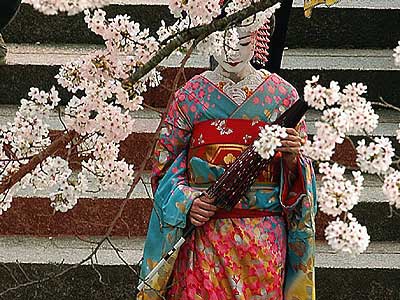EXOTISM AND MORAL IN MASCAGNI’S IRIS
an analysis by Daniele Godor
I
"'But is all my work known?' This was a question regularly
recurring in Mascagni's grief-stricken outbursts. When 'nailed by the critics to the vindictiveness of Santuzza
and Alfio' – to quote his own words –, he rejected the judgement that had
gradually become a common opinion: that he had reached his full development
with Cavalleria rusticana."[1] Mario Morini, the author of the excellent essay on
Mascagni's Iris, from which this excerpt
is taken, was absolutely right. Mascagni is a composer, who is, at least in the
awareness of the average opera listener, indeed reduced to his first big
success – a success Mascagni never managed to live up to. The fifteen operas
that followed the Sicilian tale of rustic chivalry were all outshone by the
splendidness of the debut feature: L'amico
Fritz (1891), I Rantzau (1892), Guglielmo Ratcliff (1895), Silvano (1895), Zanetto (1896), Iris
(1898), Le maschere (1901), Amica (1905), Isabeau (1911), Parisina
(1913), Lodoletta (1917), Sì (1919), Il piccolo Marat (1921), Pinotta
(1932) and Nerone (1935).
Mascagni's choice of libretti shows that he did not intend to continue
writing music in the veristic vein. The diversity of the subjects rather makes
one assume that Mascagni could have been in search of his own peculiar style.
As opposed to Puccini, who had a foible for romantic love stories against the
background of more or less exotic settings, and unlike Wagner, who attended to
subjects inspired by ancient German sagas, Mascagni does not seem to have found
the thread. A veristic novel by Verga inspired Cavalleria rusticana, Guglielmo
Ratcliff was an adaptation of an original piece by Heinrich Heine, Iris rose from the wake of the decadent
fin-de-siècle-literature, Parisina resulted
from a fructuous collaboration with Gabriele D'Annunzio and Sì was an operetta. Il piccolo Marat dealt, like Giordano's Andrea Chénier, with the French Revolution, while Nerone was perceived as an homage to
Benito Mussolini and a rather meagre copy of the opera with same title by Arrigo Boito.
The works are poles apart also from a musical point of view. Cavalleria is considered to be the
successful birth of Italian verismo,
while Ratcliff suffers from the stiff
measure of the libretto: the dactyls, which were consequently used by Heine and
the translator Andrea Maffei, made a free musical development almost impossible
– the music sounds as stiff as the text. Iris
was in contrast to Ratcliff an opera
with a rather short libretto, a libretto à la mode, sultry, decadent and exotic
– something that strongly influenced the music. Parisina contained very conservative elements, choral pieces which
sound like madrigals from the 16th century – expression of
Mascagni's sympathy for the reactionary Italian movement, which fought for the
tradition of imitatio ("neomadrigalism") and was influential
during the 1910s and 1920s. How far the imitation of old, "genuine"
Italian masters went, can be heard in some of the works of Malipiero (Le stagioni Italiche), Pizzetti (Requiem or the D'Annunzio-cycle Sogni di terre lontane) or Respighi (Concerto gregoriano for violin and
orchestra or the cycle Vetrate di chiesa
for piano). Il piccolo Marat, one of
Mascagni's most difficult operas, is by no means a "modern" or
"atonal" work, but contains only very few melodies and lots of sprechgesang. A bigger contrast to the
melodious Cavalleria is almost unthinkable.
But is there really no thread, no link between Mascagni's works from Cavalleria to Nerone? Was the public, which called for another Cavalleria, right when they said that
they had waited in vain? The answer is no. A characteristic Mascagni sound can
be heard in all of his works, and the tragic failure of many of his later works
reminds a little bit of the case of Arnold Schönberg and his Verklärte Nacht, one of his first and
most often performed compositions. "When I am asked why I no longer compose
as I did when I wrote Verklärte Nacht,
I generally reply that I do still compose in the same way, but it's not my
fault if people do not realise it", Schönberg replied in 1927.[2]
Sure enough: in Il piccolo Marat and Nerone Mascagni tried to break new
grounds by underdosing the melodious character of the music. But just these
operas demonstrate better than any other that it was the melody that was
Mascagni's greatest gift: the only consumable extract from Il piccolo Marat is the duet Va
nella tua stanzetta, a surprisingly melodious island amidst an ocean of
recitativi, sprechgesang and leitmotifs. The same applies to Nerone, where we can find a beautiful
serenade and a lovely duet, surrounded by music which first of all seems to
reflect the nervousness and neurosis of the main character. These
"melodious islands" give an account of what Mascagni really was, what
we can hear is a small rest of the gold dust that enthused in Cavalleria rusticana.
Why did Mascagni partly abandon the principle of the melody? Because it
seemed old-fashioned after the death of Puccini? Certainly not, the use of
melody in Il piccolo Marat and Nerone provides impressive counter-examples:
the music flows in a passionate cantabile,
just the way it did in Cavalleria. Signs of any "modernisation" of
melody are not evident. Mascagni's music seems to be strictly divided in "melody"
on one side and "non-melody" on the other, just like Benedetto Croce
divided literature in "poesia" and "non-poesia". But
Mascagni's "melody", his "poetry" did not alter with the
years; while his "non-melody", his prose, improved and tended to oust
the poetry in his late works.
It
seems more probable that Mascagni tried to strike new paths because of the
disappointments he had with all the strictly melodious, poetic and non-prosaic
works that had followed Cavalleria rusticana.
Mascagni never managed to link to the density of melody and the richness of
musical invention that he had presented in Cavalleria
rusticana. After a long history of failures he might have felt that his
poetry had become noneffective and that he should try to write in prose
instead. But deserve his other operas really to be forgotten, or asked the other
way round: must we know all of Mascagni's works? The answer is again no. Do
works like Giordano's Madame Sans-Gêne
(1915) and Cena delle beffe (1924)
deserve as much attention as his stroke of genius, Andrea Chénier? What about Leoncavallo's Zazà (1900) and Maja
(1910) or Ponchielli's Lina (1877)?
Maybe not. And the same applies to many works of Mascagni, which may be of
interest for the musicologist, but not likewise attractive for the average operagoer.
Many of Mascagni's works don't have the same quality as Cavalleria rusticana and so justifiably
stay in the background. But many does
not mean all – and one
work that has been treated inequitably and has not been given the
attention it definitely would have deserved is Iris.
II
The genesis of Iris took four
years. In 1894, Luigi Illica, who had written the libretti Il vassallo di Szigeth (with Francesco Pozza) for Smareglia (1884), La
Wally for Catalani (1889), Cristoforo
Colombo for Franchetti (1889), Manon
Lescaut (with Domenico Oliva) for Puccini (1893), Cornelius Schut for Smareglia (1893) and La martire for Samaras (1894), mentioned a "Japanese
subject", a legend entitled L'innamorata
dei fiori (The flower lover).
Japan was in great vogue in Italy since Gabriele D'Annunzio, Italy's leading
poet, aesthete and arbiter elegantiarium, had introduced the so-called giapponismo to the high society in Rome.
"Japan (…) expressed its rhythms and floral conceits in precious
ornamentation on multicoloured silks, panels, prints, fans and bibelots: things
that enchanted the ladies of the Roman aristocracy when D'Annunzio took them on
visits to the 'oriental' shops in Via
Condotti" (Morini).
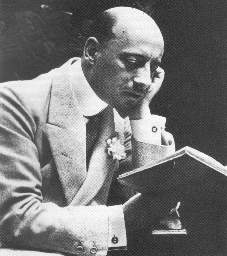
Gabriele D'Annunzio
Brocades, oriental carpets, peacock feathers, feather pillows, the
colours red and purple, bric-à-brac, a general abundance of decors, ornaments
and patterns, symbols and a preference for pre-Raphaelite women with heavy,
long red hair, long throats and languishing but passionate miens characterised
furthermore the taste of the fin-de-siècle. The fin-de-siècle-movement and its
orientalism were undoubtedly a reaction against the "proletarian"
realism and naturalism and the ugliness of industrialisation – and therewith a
movement against the verism that was constitutive of Cavalleria rusticana. Orientalism had, just as the
fin-de-siècle-movement, originally come from France, where it was widely spread
not only in literature but also in musical works. It soon became a taste of
international quality, a fact of which the works of Messager (Madame Chrisanthème, 1893), Gilbert
& Sullivan (The Mikado or The town of Titipu, 1885) and
Jones (Geisha 1896) bear witness. And
Iris was about to become the first
Italian opera against the background of a Japanese setting.[3]
Illica did not have Mascagni in mind when he wrote the libretto inspired
by L'innamorata dei fiori. He thought
that Alberto Franchetti (Cristoforo
Colombo, 1892) would be the only composer who could write the music for the
Japanese legend. But Franchetti was not interested and rejected the libretto
because he was, as he said himself, unable to "hear the music" for
the libretto. He strangely enough said the same about Illica's Tosca and Andrea Chénier – also those libretti had originally been written
for Franchetti who rejected them for the same reason.[4] But Illica kept working on the libretto, modified the
name of the main character from Aloe
into Miosotis, and finally, into Iris. Illica was a famous author in his
time, and he had not only made a name as successful librettist. He had
published a book of poetry (Farfalle –
Effetti di luce, 1888) and a series of plays, which were regularly
performed by the most famous companies: I
Narbonnerie-Latour (1883), Il conte
Marcello Bernieri (1883), La signora
Leo Pascal (1884), Henrik Arpad
Tekeli (1884, Gli ibridi (1886)
and many others.
Thus Illica was a librettist with high artistic aspirations. He used
Franchetti's refusal as an opportunity, refined the text and weaved in elements
of the literary fashion of his time. At the same time he experimented with an
approach new to the history of the Italian libretto: the elimination of the old
eloquence. The libretto should be shorter, fewer words, higher density, more
poetry, a condensate instead of eloquence. Carlo Mascaretti, a contemporary of
Illica and a severe critic with the most refined taste, wrote to the
librettist:
"You have so much accentuated
the new path you have sketched with your librettos that I feel this Iris really constitutes a whole
evolution for such kind of compositions. (…) Fewer words for music than in
former librettos, but a greater abundance of ideas and, more particularly, of
poetry."[5]
It was not before March 1896 that Illica handed the libretto over to Mascagni,
who was, in contrast to Franchetti, at once hooked. Also Mascagni was in search
of an "idea for a new opera. New forms open up, as it were, a new horizon,
a kind of new expression."[6] And
under the aegis of Giulio Ricordi, Mascagni and Illica signed up on March 23rd,
1896.
Mascagni started the work on Iris with
great drive and fervour, studying Japanese music and instruments. In August
1896, Illica wrote to Ricordi: "He works seriously and wants to make a
serious work. This is a new Mascagni!"[7] In October 1896, Mascagni wrote to Illica: "For Iris I have many, far too many ideas,
but I want to rend all of them. I need to work calmly and methodically. I need
to concentrate now: I am chasing precious threads I do not want to lose from
sight".[8] And in September 1896: "Dear Illica, (…) I am
still studying Japanese harmony and I think that the result will be a work of
great originality. Even better: the music and the libretto will compete with
each other when it comes to originality. The critics will not understand
anything and hence write good critics."[9]
Iris
first saw the light of the stage on the 22nd of November 1898 at the Teatro Costanzi in Rome, with H. Darclée
as Iris, De Lucia as Osaka, Caruson as Kyoto, Tisci-Rubini as the blind father. The composer himself
conducted the performance. The opera was well received and played for another
nine times at the Teatro Costanzi.
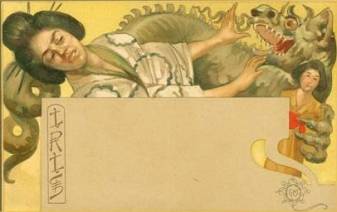
III
The following synopsis is an excerpt from a longer article by Alma Dalma
and was published in the Cosmopolitan
magazine in 1897:
"Briefly,
the plot of 'Iris' is as follows: Iris [soprano] is an innocent young Japanese
maiden who lives with her old blind father [bass]. She does not know the huge
world, or its passions and its weaknesses. To her, the whole of life is one
long dream of goodness and song and happiness. She sings to the sun and sings
to her doll. In this pearl of a child her father forgets his affliction, and
the two are absolutely devoted to one another. A very pretty scene occurs
between father and daughter.
The hero, a rich young Japanese
prince [Osaka, tenor], whose admiration for the beautiful is a ruling passion,
sees the girl and hears her sing. His passion and love are awakened, and the
idea of securing possession of her dominates his mind. By the villainy of his
satellite [Kyoto, baritone], he succeeds in stealing her during the poor blind
father's absence. This scene is a most dramatic one. In this act, Iris has a
song that is sure to become as famous as the Intermezzo, for beauty. The tenor
and the father also have splendid opportunities. The scene ends as the father
enters the empty home and calls vainly for his lost child.
The second act is replete with
brilliancy and colour. The scene is laid in the gayest part of Tokyo. The
teahouses are brilliantly illuminated, the sound of the samisen and koto is
heard, pretty geishas go hither and thither, guests are transported to and from
in their picturesque jinrikishas, and there is lively action throughout. Hither
Iris has been brought by the wicked prince. Yet she is still innocent, and
firmly believes that the gay world she sees for the first time is the paradise
of which her father has often told her.
Confident that a feature of
residence in paradise is the fact that an inhabitant is gifted with the power
to accomplish anything desired, Iris tries to paint. Alas! the colors will not
blend; the result is a daub; and disappointment follows. She next tries to play
the samisen, but all is discord. At last, in an outburst of childish fury, she
dashes her playthings to the floor and destroys the samisen, and curses in an
artless Japanese way. At this juncture the father, who has been groping his way
all over Tokio in search of Iris, enters and hears her angry words, and,
convinced that all, even honor, is lost to her, condemns, disowns and discards
her. Here again the finale is a grand climax of harmony. All the fire and
passion and melody that Mascagni so well knows how to employ are invoked with
great effect.
The play ends with the finding in
the early morning of a jewel, by some Japanese ragpickers. Searching further,
they find the body of Iris – a dramatic and unusual ending, surely, for an
opera.
During the second act there is an
excellent comic song for the tenor and a magnificent duet for Iris and the
prince. Iris is written in three acts, or perhaps it would be more correct to
say a prologue and two acts. Several competent critics, who have read the
libretto and heard the music at a private hearing in Cerignola, Italy, declare
that success for Iris is a foregone conclusion. Mascagni recently wrote me:
'The book is splendid. If my music pleases, we shall have an enormous
success.'"
Even though Alma Dalma's synopsis contains a couple of odd views I found
it interesting as historical source. Beyond, it's a sufficient ground orientation
for the following analysis.
The genesis of the protagonist's name Iris is very interesting and indicates that Iris could be more than just a coincidental name. First, Illica
called the girl Aloe, then he went
over to Miosotis. Both are flowers, a
fact that is not so strange, given that the plot is about a "flower
lover". Two other aspects are of greater interest: the symbolic meaning of
each of the flowers and the symbol that lies within the fact that the girl who
loves flowers actually has a flower's name. Aloe
is associated with eternal youth, while Miosotis
stands for pure love. Iris again
is a symbolic message – what message? The message of pure, innocent, youthful
love? Iris does most probably not
only have a flower's name because she loves flowers. That she has it could mean
that Iris possesses the qualities of
a flower: freshness, pureness, innocence maybe, and fragility. But over all it
symbolises her bond with nature. She is a part of nature, the bond is almost a
fusion, a Pandean fusion of man and nature.
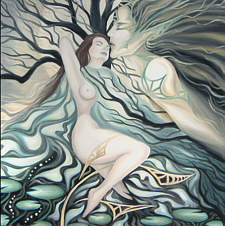
The Pandean worldview was widely spread around the turn of the century and
a natural reaction against the automation of life and, on the other side, the
cult of dissolving the own self, to break up with it, and to resurge as a part of
nature.
The Iris was, beside that, one of the most popular flowers of the time,
and it has been used as pattern and decor on countless objects of arts and
craft.
The names of her counter-parts are, absurdly enough, names of big
Japanese cities: Osaka and Kyoto. While it is possible to have Osaka as a family name, it is completely
impossible to be called Kyoto. But
the message is clear: Here we have two representatives of the modern
civilisation, which contrast strongly with the Pandean flower girl.[10]
The libretto starts with a long introduction by a narrator, who does not
only describe the opening scene, but also comments
the places and events he gives account of. He is both omniscient narrator and
authorial voice. The narrator describes the sunrise,
personifying the nature according to the Pandean principle:
"The night leaves the sky. (...)
The flowers in Iris' small garden lift their heads like curious children and
turn towards east. (...) O light, soul of the world! (...) The morning triumphed!
(...) The light is the idiom of the eternal."
The idiom of the eternal ones, the idiom of God? Who would be able to
decode it? The almighty poet can! Here comes what the sun, the light, the
idiom of God has to say:
THE SUN: "It's me, it's me, the
life! The infinite beauty, the light and the heat. Love, ye things, I say! I am
the old and new God, love, I am the love. (…) I descend to you, little girl,
just as I descend to Kings! (…) Eternal poetry, heat, light, love!"
The narrator adds:
"The girl, which listens to the
language of the Sun and transforms it into kindness, is Iris. (…) The sunshine
and the soul of the girl unify heaven and earth; the infinity of space is
won."
What we have here is a Pandean concept on several levels. Iris is a part of the world and can
communicate with the sun, translate its language. The narrator/poet, who
comments the dialogue, decodes the divine language as well, which is not only
Pandean but also Orphic. The poet is the translator of the divine language; he
makes the sun sing in a language we can understand! By Pandean participation in
the world process (the rising sun for example), the artist (poet, narrator)
becomes Orphic, identifying himself with the limitless variety of nature and
becoming its direct expression. Nature is anthropomorphised and humans naturalised.
This
was, as Jürgen Maehder pointed out, a new feature in the history of the Italian
opera.
Then the actual action begins. Iris,
alone in the garden speaks to the flowers and the sun. She thanks the sun for
having chased away the night's nightmares. When her blind father enters the
scene and asks her to whom she is talking, she replies with implicitness:
"With the Sun, o my father!"
Iris and
her father are secretly observed by Osaka
and Kyoto, who intend to abduct Iris into the Yoshiwara, a "pleasure quarter" and red light district in
Edo (Tokyo).[11] Osaka is
attracted by the girl's beauty, and both scent a business that pays. They
decide to stage a puppet theatre in order to confuse the blind father, bedazzle
the naive girl and abduct her.
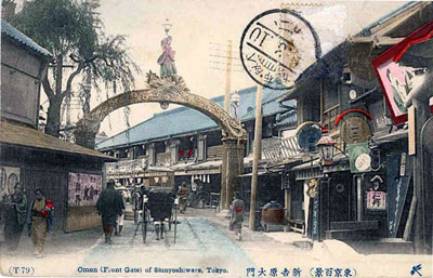
The gates of Yoshiwara[12]
The following scenes are a musical firework of rare intensity. The
richness of the musical ideas of Mascagni offers unequalled opportunities. First a
group of laundresses enter the scene, illustrated by a dance of rare beauty.
They're on their way down to the river and praise the full moon, which makes
the water "calm and mild". A short scene in the garden, where Iris sings a song to the flowers while
her father speaks his prayer, follows their dance. The simple melody Iris sings with her light soprano
contrasts beautifully to the sprechgesang
of her father, who is a basso profondo. Suddenly they hear the sound of
instruments, "sounds of samisen, gongs, drumbeats and koliu":
"It's the comedians, it's the geishas!"
Monitored by Kyoto, the
geishas and Osaka put on a moving
play, of which Iris is at once
fascinated. The play itself is a caricature of the scene in the garden which Osaka and Kyoto had observed earlier: An unhappy girl ("Dhia") is
mistreated by her father ("Il padre", played by Kyoto) and finally saved by "Jor", the "Son of the
Sun" (played by Osaka). The play
hits its peak with the beautiful and tender aria Apri la tua finestra, also know as Serenata di Jor, the most famous piece of the whole opera:
JOR FIGLIO DEL SOLE
(Osaka) JOR,
SON OF THE SUN (Osaka)
Apri la tua finestra! – Jor son io Open your
window, it's me, Jor,
che vengo al tuo chiamar, povera Dhia! who responds to your call,
poor Dhia!
Apri la tua finestra al raggio mio! Open your window
for my rays!
Apri il tuo cor a mia calda malìa! Open
you heart for my ardent desire!
Jor ha ascoltata, o Dhia, la tua preghiera! Jor answers your prayer, o Dhia!
Apri l'anima tua, fanciulla, al Sole! Open
your soul for the Sun, dear girl!
Apri l'anima tua alle mie parole! Open
your soul for my words!
Apri il tuo cuore a me, fanciulla, e spera! Open your heart for me, dear girl, and hope!
Tu vuoi morir? – Morire io ti farò, You
want to die? – I'll make you die,
ma ti farò morir dal Sol baciata, but make
you die kissed by the Sun
poscia al paese eterno ti trarrò then
I'll bring you into the eternal realm
ove, o fanciulla, tu sarai amata! where you, dear girl, are going to be loved!
The name Osaka adopts during
the play is a matter of particular interest. He calls himself Jor, the son of the sun. It's not
astonishing that Osaka uses the
surname Son of the sun: He has
observed Iris in the garden and knows
about her affection for the sun. But what kind of name is Jor? In the rune alphabet of the old Futhark we can find the rune "M", which has the name Jor. Its meaning is mystery and secret.
Every rune of the old Futhark has a
dedicated number. Jor's number is 18.
If we consult the Tarot and its
mysticism of numbers, a surprising discovery can be made: card number 18 in the
classical Tarot deck is "The
Moon", the diametrically opposed counterpart of the sun! The same moon
that laundresses have anticipated in their song just a few lines earlier.
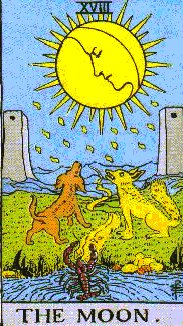
The Tarot game was well known in Italy since the Middle Ages under the name Tarocchi,
and its rich symbolism was a
source of inspiration for Renaissance art and for modern Italian literature.[13] What does the card stand for? It stands for danger,
insincerity, false friends, double dealing, false pretends, falling into a
trap. In the poetry of the turn of the century, the moon is the incarnation of
the threatening and fatal evil, devilish and demoniac, man's
most dangerous enemy par excellence, "the cold moon, who drops her poison
deeply in his blood/like an experienced doctor" (Georg Heym).[14] In
most of the old heathen religions we can find similar associations.
As to the protagonists the result of the present analysis can be
summarised in the following antithetic structure:
IRIS: young and innocent girl. The name Iris
stands
OSAKA: stands for the
modern town
for
nature, whilst the flower was a popular and
civilisation. He works at the
symbol
around 1900. Yoshiwara,
desires Iris and intends
Iris stands for the sun and can
communicate to abduct her. He is symbolised
by
with nature. the
moon.
KYOTO: is as unsympathetic as
Osaka.
Also Kyoto stands for a negatively
perceived
civilisation. Iris is nothing
to him but an object he can
sell with profit.
What about the blind father? He lets Iris
watch the play but warns her steadily: "They're vagabonds", "the
whole play is falsehood" etc. And as he finally asks Iris for her opinion, she is already gone, abducted by Osaka and Kyoto. In black despair the father cries for Iris, but the only ones who answer him are passers-by. "Your
house is empty", they say, "Iris is not here!" Suddenly they
find a sheet of paper and some money, both left by Osaka and Kyoto. The
sheet of paper is a faked farewell letter, which the passers-by read for the
blind father: "The money is for you. Your daughter went to Yoshiwara!" The father breaks down
in despair and cries:
"I want to slap
her and spit her in her face... and curse her! Iris! My life...! And then, and
then..."
The whole scene is accompanied by one of the most intense and beautiful
moments of music that Mascagni has ever written.
The rest of the libretto can be resumed in few words. Osaka and Kyoto abduct Iris to Yoshiwara, which is described
by the narrator as a place "without light, without the harmony of the
sun". Yoshiwara is Osaka's realm, it is night, and the moon
shines brightly. Kyoto and Osaka watch the sleeping girl: "A
cherry, ready to be picked and eaten."
As Iris awakes, Osaka tries to win her over with
passionate words, illustrated by Mascagni by one of his finest and original
melodies (Oh come al tuo sottile corpo).
Iris still believes that Osaka is Jor, and Osaka does not
do anything to disabuse her, on the contrary: "You still think that I am Jor, but this is not a play, this is
real life. And in real life I am called… Lust!"
But Osaka does not succeed: Iris can't think about anything else
than going back to her small garden, the flowers, the sun and her father. Osaka, irritated by her stubbornness,
gives up and leaves her to Kyoto, who
puts her into a "transparent dress" and finally presents her on the
market in order to exploit her youthful beauty. Kyoto puts her on display for the admiring populace, but suddenly
her blind father appears. Iris,
overjoyed, greets him: "Father, I am here, it's me, Iris, come here,
here!" But her father, still in anger and unable to forgive, curses her.
Blind with rage he stoops, grabs mud and throws it into the direction his
daughter's voice came from: "Mud... on your face!... On your mouth!... In your
eyes!" Iris, overwhelmed by so
much anger, dives into a sewer hole in self-punishment.
One of the interesting features of act II is a play of words that again
deals with symbols and myths. Iris,
captured in Osaka's (the moon's)
realm, succeeds – in spite of all the filth, lust, decadence and mud that is
loaded onto her – in emerging as a symbol of beauty, innocence and pureness:
she stays, although captured in the moon's realm, the sun she was in act I. Is
it a coincidence that the constriction of the names Osaka and Iris results in
Osiris and that Osiris, the Egyptian god of resurrection, is symbolised by a
nocturnal sun?
The last act is another unicum in the history of opera. It's crack of
dawn and ragpickers find the dying, hallucinating Iris. In the libretto the narrator comments the scene with the
following words:
"And Iris' lips form for one
last time the question, the big accuse against the world, the destiny or the
divinity: why?…"
Neither Osaka, nor Kyoto nor her father answers her
question. But Mascagni and Illica make us hear three phantom voices instead:
"Osaka's egoism", "Kyoto's egoism" and "The blind
father's egoism"! Let's hear what they have to say. Osaka's egoism:
"You die like the flower that
dies for its odour. In my grim egoism, I'll now take elsewhere my phantasmal smile and song.
That's life! Good bye!"
Kyoto's egoism:
"I wear the
livery of the greatest of all kings: the lust! Now we are here. I am because of
my inhuman meanness, you are because you are the victim of your own beauty.
Why? I don't know. That's life! I go now!"
The blind father's egoism:
"Alas, who
is going to light the fire in wintertime (...)? That's the thought that is the
cause of my tears and that is the cause of my deepest sorrow. That's life!
Farewell!"
Iris
dies as the first sunrays touch her face. And the sun talks to Iris:
"Iris, immortal Iris, come to
me! Give your body to the flowers, your soul is mine."
The girl dies, as the narrator concludes, "with the great vision of
immortality", and, just as Jor sings
in his aria, kissed by the sun. The opera ends just the way it started: with
the singing sun, a sun that chases away the night phantoms and closes the
eyes of those who were broken down by the nocturnal powers.
IV
The opera Iris has a clear
moral message: The world, or more precisely: the part of the world presented in
the opera, is ruled by powers which here are symbolised by the night, by the
moon, by all things nocturnal. The nocturnal side, represented by Osaka, Kyoto and the blind father
includes falsehood, decadence, lust, capitalistic exploitation, greed,
indifference and egoism. The fact that characters that have names of big cities
mainly represent this side makes one assume a general scepticism against modern
civilisation.
Iris is innocent, pure and, what
is of great importance, harmless and fragile like a flower. She is naive, wants
everybody to feel good and has empathy with all those who are mistreated by
others. That's why the play staged by Osaka
and Kyoto is so striking. Iris is good, but the pure good has no chance in a world, which is
dominated by Osakas and Kyotos.
What we have here is, of course, the ancient problem of Christianity:
Why is there so much evil (Iris asks that question) and what can one do against
it? I don't even try to presume giving an answer, but the answer that
Mascagni and Illica give is pessimistic. Jesus Christ's martyrdom had an
effect on his contemporaries, and his doctrine has conquered big parts of the world.
But Iris? She suffers and does not
fight back (which is good), but nobody
regrets her death. Everything and everybody, and that's what we
see in act III, goes just back to normal.
Mascagni and Illica place the big question: why is the world as it is? But this is the terminal point, or
to say it with he words of Eugenio Montale: "The error of nature, the dead
point of the world, the ring that does not hold, the clew that has to be
untangled and that would lead us in the middle of a truth."[15]
Another Italian poet and, like Montale, a contemporary of Mascagni and Illica,
Giuseppe Ungaretti, wrote a poem that comes very close to the atmosphere
created in the last act of Iris. I
would like to conclude this essay with some excerpts. The poem has been written
under the impressions of a battle during the First World War, where Ungaretti
was a front soldier in the Italian army.
WHY? PERCHÉ?
Some rest is needed Ha bisogno di qualche ristoro
by my
dark and lost heart il
mio buio cuore disperso
In the
muddy trenches of stone negli incastri fangosi dei sassi
like a
blade of grass come un'erba di questa contrada
it
wants to shiver slowly to the light. vuole tremare piano alla luce.
But I
am nothing Ma io non sono
in the
sling of time nella fionda del tempo
but a
splint of the stone fragmented che la scaglia dei sassi tarlati
by the
improvised road dell'improvisata strada
of
war. di
guerra.
Ever
since Da quando
he has
watched into ha
guardato nel viso
the
immortal face of the world immortale del mondo
this
crazy one wanted to know questo pazzo ha voluto sapere
fallen
into the labyrinth cadendo nel labirinto
of his
sorrowful heart del suo cuore crucciato.
(...) (...)
I
watch the horizon Guardo l'orizzonte
poxed
by craters. che si vaiola di crateri.
My
heart wants to illuminate itself Il
mio cuore vuole illuminarsi
like
in this night come questa notte
at
least with the shooting rockets. almeno di zampilli di razzi.
(...) (...)
My
poor heart Il
mio povero cuore
aghast sbigottito
at not
knowing. di
non sapere. [16]
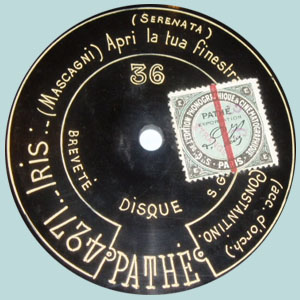
***
Sources/references:
-
Ghirardini,
Gherardo: Invito all'ascolto di Mascagni, Invito all'ascolto, vol. 11.Milano
1988
-
Maehder, J–rgen: Il primo esotismo giapponese sulla
scena italiana – Iris di Luigi Illica e Pietro Mascagni. Rome 1996, pp. 79–93.
-
Morini, Mario:
Iris; booklet for the LP edition of Iris
with M. Olivero, S. Puma and S. Meletti (Archivio RAI LAR 23)
-
Morini, Mario
(ed.): Pietro Mascagni. Milan 1964,
p. 308
-
Ostali, Pietro:
Mascagni e l'Iris fra simbolismo e floreale. Milano 1989
Further reading:
-
www.librettidopera.it/iris/iris.html (the complete libretto in typographical print)
